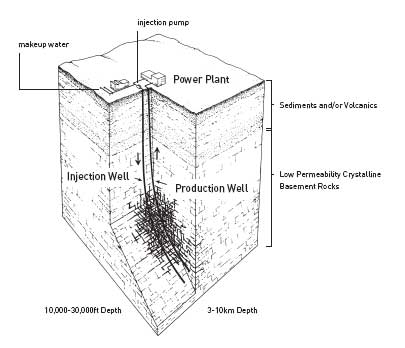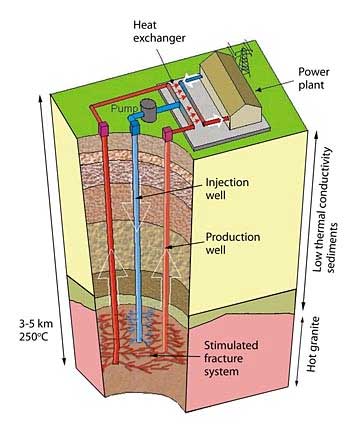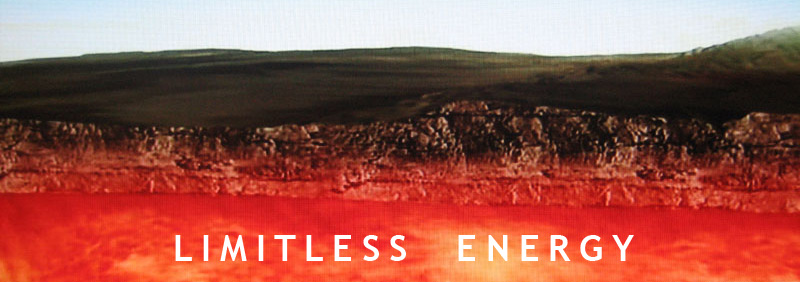Presently, a cross the globe many countries are looking to the heat of hot rocks for future energy need. In areas of the world where steam is not as close to the surface as it is at the geysers, engineers are experimenting with process called "Hot Dry Rock Technology" or "Hot Fractured Rock" (HFR) or "Enhanced Geothermal System" (EGS).
In hot dry rock geothermal technology there is no steam lock up in the hot rocks that exist down under the crust so scientist in the U.S.A., Japan, England, France, Germany, Sweden, Switzerland, Belgium and Australia, have experimented with piping water into this deep hot rock to create more hydrothermal resources for use in Conventional Geothermal Power Plants. The simplest hot dry rock power plant comprises one injection well and one production well.
What they try to do is to select appropriate location with a large mass of sub-horizontal hot rocks with adequate permeability, and if necessary enhance permeability with controversial "Fracking" (Hydraulic Fracturing), and then drill down injection well into the rock and then injected down into well, under pressure, what ever water source they have happen to have on the surface, hoping that it will travel through cracks and fissures and form underground reservoir, and exchange heat in the hot granite and then drill more production wells around perimeter and try to recover that water and steam by pumping it back to the surface and then use it in a conventional or in a "binary" power plant.


Here is illustrated schematic of a conceptual two-wells
Enhanced Geothermal System in hot rock
in a low permeability crystalline basement formation.
Courtesy of: www1.eere.energy.gov/geothermal/egs_technology.html
Here is illustrated schematic of another conceptual three-wells Enhanced Geothermal System (EGS) in hot rock - 3D cutaway - diagram modified from ANU Hot Rock Energy website.
Courtesy of: hotrock.anu.edu.au.
Limitations of the experimental Enhanced Geothermal Systems (EGS)
In order to function properly Enhanced Geothermal Systems (EGS) needs three crucial factors: Water, Permeability of the rocks and Heat.
The power generating ability of the hot rock circulation system is critically dependent on the hot rock temperature, the flow rate of water through the hot rocks and the actual volume of hot rock that the circulating water comes in contact with. The crucial factor therefore is adequate permeability in the hot rock, so that sufficient volumes of formation or injected water can circulate freely through a large mass of sub-horizontal hot rock to become superheated.
This method also depends on locations which should have, beside enough heat also sub-horizontal layers of rocks structure to permits horizontal flow of injected water through hot rocks and adequate permeability of the hot rocks to provide adequate water flow through hot rocks. This method also depends on locations which should have access to substantial source of necessary water.
The idea to use hot rocks for production of electricity has been around since 1970s, and numerous attempts are made. Although “Enhanced Geothermal Systems” (EGS) is focused on right target, Hot Dry Rocks, its method is not adequate. There are many obstacles/challenges/limitations with this system that would need to be overcome.
To mention just a few:
1. Searching for and locating a large mass of sub-horizontal rocks with adequate permeability to provide adequate water flow through hot rocks is a challenge with significant limitations.
2. If permeability is not adequate enhancing it with controversial fracking (Hydraulic Fracturing), using high pressured water and/or chemicals might be expensive and environmentally unfriendly challenge.
3. Forming substantial artificial reservoir a few miles under surface at location where water has never been naturally accumulated is a challenge.
4. There is strong possibilities that water from artificial reservoir may bypass production well(s) and runaway in opposite direction from production well(s).
5. To have access to substantial supply of water (at least 1 cubic kilometer) to form an artificial reservoir, deep under, at size about one cubic kilometer, is a significant limitation and challenge.
6. Lost of heat during pumping water up to the surface a few miles through layers of relatively cold rocks is an obstacle.
7. To have constant supply of additional water to substitute expected constant lost of water during this process, is a limitation.
8. Also, possibility of inducing seismicity is serious factor to consider. The injected water can accumulate into underground pre-existing pockets (caves) and when critical mass and temperature is reached can produce explosion which can trigger earthquake, especially if seismic tension already exist at that area.
 Geothermal Worldwide, Inc.
Geothermal Worldwide, Inc.
